[vc_row][vc_column width=”1/1″][vc_column_text]The Hornet UAS has the ability to carry a number of cameras that can produce useful information for precision farming operations. Some examples included in Crop-Tech’s evaluation are a regular camera, giving an aerial view of visible field conditions, and a modified near infrared camera, which provides an indication of plant health beyond what would otherwise be visible to the human eye. Agribotix’s processing services stitch the multitude of images collected in a typical flight into a single image that can be viewed in many of today’s GIS programs or as a Google Earth overlay. Agribotix also processes the near infrared imagery into a single, vegetative index image that can be used for crop scouting purposes. While UAS do not yet possess the range and economy of a manned platform, the greater temporal and spatial resolution could prove very useful for evaluating small, high risk areas within a farming operation.[/vc_column_text][/vc_column][/vc_row][vc_row][vc_column width=”1/1″][vc_gallery type=”flexslider_fade” interval=”3″ images=”5100,5102,5106″ onclick=”link_image” custom_links_target=”_self” img_size=”full”][/vc_column][/vc_row][vc_row][vc_column width=”1/1″][vc_column_text]The Hornet UAS proved to be an extremely easy platform to fly. From planning flights with the Mission Planner software to the actual flight and recovery, the whole process was very intuitive. The actual flight, once the platform is launched from the bungee launch system, is nearly entirely autonomous. While the operator can take control of the system at any point in the event of an emergency, the Hornet will fly the mission and even land on its own. This level of autonomy reflects the effort of the Agribotix team to ensure their Hornet UAS platform is as user friendly as possible. – JOE[/vc_column_text][/vc_column][/vc_row]
